 |
 |
 |
| |
Is Twice-Daily Unboosted Atazanavir 200 mg Worth a Harder Look?
|
| |
| |
9th International Workshop on Clinical Pharmacology of HIV Therapy
7-9 April 2008
New Orleans
Mark Mascolini,
Contribution by Jules Levin
From Jules: twice-daily 200mg Reyataz could be used in combination with Raltegravir or Maraviroc, they could be coformulated. Although this utility was not mentioned by Bonora, his findings of an improved trough and similar AUC for the 200mg BID Reyataz regimen compared to the once daily 400 mg dose provides support for the idea of studying twice daily Reyataz 200mg in combination with Raltegravir and Maraviroc. Both Raltegravir and Maraviroc have very friendly lipid profiles as does Reyataz, so this lends itself well to study this combination as it might provide significant metabolic, tolerability, and safety benefits. The Maraviroc lipids profile was presented at the 2008 CROI.
Unboosted atazanavir at a dose of 200 mg twice daily yielded a better plasma concentration profile than an unboosted 400 mg once daily in a small pilot study [1]. The intracellular penetration remained equivalent with twice-daily and once-daily unboosted atazanavir, and plasma troughs with either dose were lower than those attained with atazanavir/ritonavir.
Stefano Bonora (University of Turin) noted that an unboosted 400 mg of atazanavir (ATV) has gained popularity across Europe and especially in Italy, even though European regulators do not sanction that dose. To make his case Bonora cites a study in his oral talk that reported up to 20-40% of patients taking 400mg QD experienced a low ATV trough (<150 ng/mL , minimum effective concentration) [2]; as you can see from graph below some patients taking ATV/r 300/100 also experience low troughs; a clinical study comparing 400 mg QD to ATV/r 300/100 mg QD showed similar efficacy although there were more viral failures in the 400 mg dose; what drives viral failure, AUC or trough?? To what extent does trough affect response? Bonora also said no one has studied intracellular accumulation of once-daily atazanavir in a clinic population. So Bonora and colleagues recruited 10 people taking 400 mg of this protease inhibitor (PI) once daily who were willing to switch to 200 mg twice daily for 10 days.
Everyone had a viral load under 50 copies, a CD4 count above 300, and self-reported adherence better than 90%. No one was taking a drug that might interfere with atazanavir, except for tenofovir, and everyone was taking tenofovir plus emtricitabine. Half of the study participants were women, and the group had a median age of 39.5 years, a median weight of 70 kg, and a median CD4 count of 456. Bonora measured their atazanavir levels and 24-hour total bilirubin on day 0, then remeasured atazanavir concentrations and 12-hour total bilirubin 10 days after they switched to twice-daily atazanavir.
Atazanavir troughs were significantly higher with 200 mg twice daily than 400 mg once daily, while peak concentrations were lower with twice-daily dosing and area under the concentration-time curve (AUC) roughly equivalent:
· Once-daily geometric mean trough 138 ng/mL (95% confidence interval [CI] 58 to 220), twice-daily geometric mean trough 305 ng/mL (95% CI 162 to 448), geometric mean ratio 2.19, P = 0.005
· Once-daily geometric mean peak 2786 ng/mL (95% CI 1780 to 3792), twice-daily geometric mean peak 1314 ng/mL (95% CI 693 to 1935), geometric mean ratio 0.48, P = 0.022
· Once-daily geometric mean AUC 20,780 ng/mL/h (95% CI 14,364 to 27,196), twice-daily geometric mean AUC 16,904 ng/mL/h (95% CI 9361 to 24,447), geometric mean ratio 0.80, P = 0.441
Atazanavir troughs fell below a minimum effective concentration of 150 ng/mL in 6 of 10 people while taking once-daily atazanavir and in 2 of 10 when taking the PI twice daily. Intracellular troughs were significantly better with twice-daily dosing (745 ng/mL, 95% CI 312 to 1178) than with once-daily dosing (465 ng/mL, 95% CI 253 to 678, geometric mean ratio 1.86, P = 0.04). But the intracellular trough never fell below the 150-ng/mL cutoff with either dose. Total atazanavir exposure, or AUC, was equivalent with the two doses (geometric mean ratio 0.90, P = 0.87).
Compared with once-daily dosing, twice-daily dosing did not cause a significant jump in bilirubin levels, and giving tenofovir with twice-daily atazanavir did not result in significant intraday variability in atazanavir levels.
The adequate intracellular levels with either dose raise the question--posed by one workshop attendee--whether switching to twice-daily atazanavir will do any good in the long run. How much drug sits in cells--where all the anti-HIV action happens--matters more than how much streams through plasma. If once-daily dosing gets enough atazanavir into cells, should clinicians expose patients to the higher risk of poor adherence with twice-daily dosing?
Bonora did not compare blood levels of once- and twice-daily unboosted atazanavir with historical data on boosted atazanavir. US prescribing information lists the geometric mean atazanavir trough in HIV-infected people taking 300/100 mg of atazanavir/ritonavir once daily as 636 ng/mL [3], compared with geometric means of 138 ng/mL with 400 mg once daily and 305 ng/mL with 200 mg twice daily in Bonora's study. The higher trough with 200 mg twice daily still left 2 people (20%) with a suboptimal plasma trough, perhaps because everyone also took tenofovir, which lowers atazanavir concentrations. For the record, the FDA uses boldface type to warn that atazanavir "without ritonavir should not be coadministered with tenofovir."
(Many complete slide sets and posters from this workshop are available at www.hivpresentation.com.)
References
1. Bonora S, D'Avolio A, Tettoni C, et al. A pilot study evaluating plasma and intracellular pharmacokinetics (PK) of switching from atazanavir (ATV) 400mg QD to ATV 200 mg BID in HIV+ patients. 9th International Workshop on Clinical Pharmacology of HIV Therapy. April 7-9, 2008. New Orleans. Abstract O17.
2. Ray JE, Marriott D, Bloch MT, McLachlan AJ. Therapeutic drug monitoring of atazanavir: surveillance of pharmacotherapy in the clinic. Br J Clin Pharmacol. 2005;60:291-299.
3. US Prescribing Information for Reyataz (http://packageinserts.bms.com/pi/pi_reyataz.pdf).
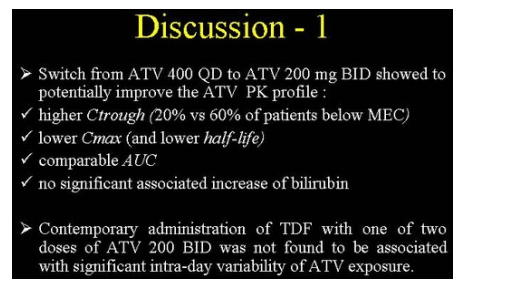
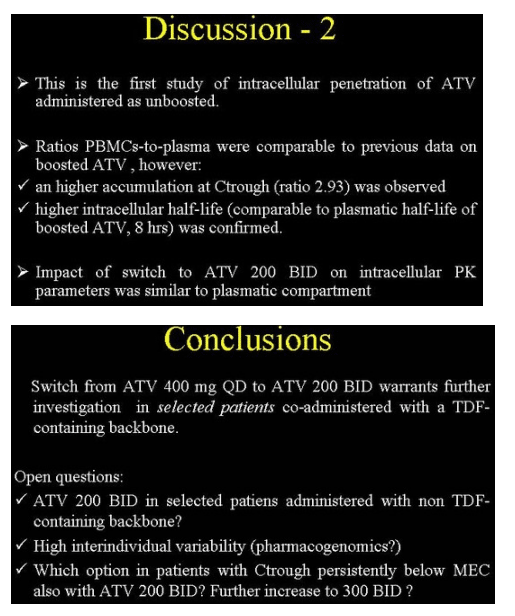
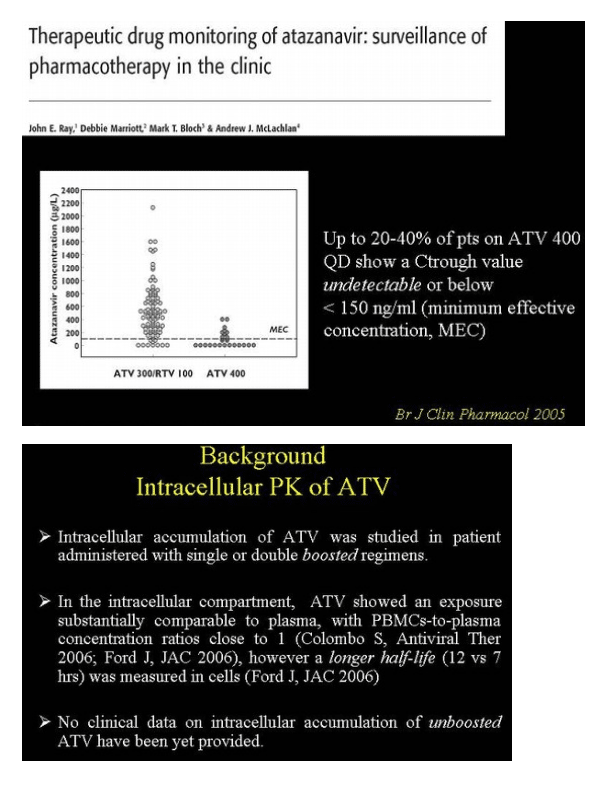
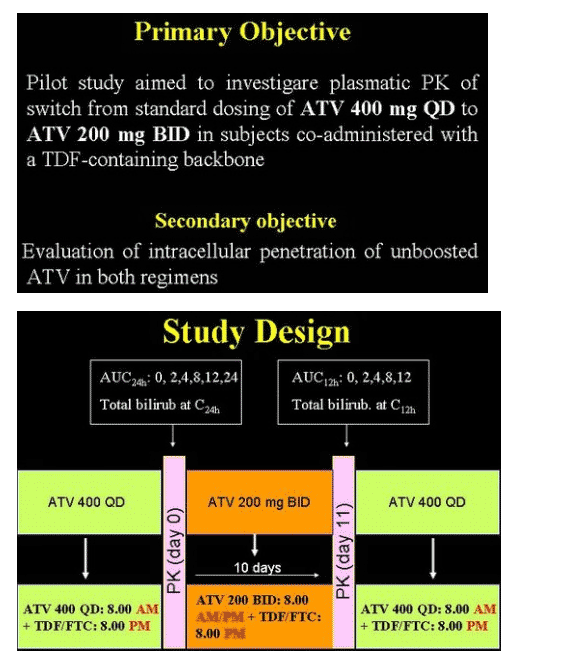
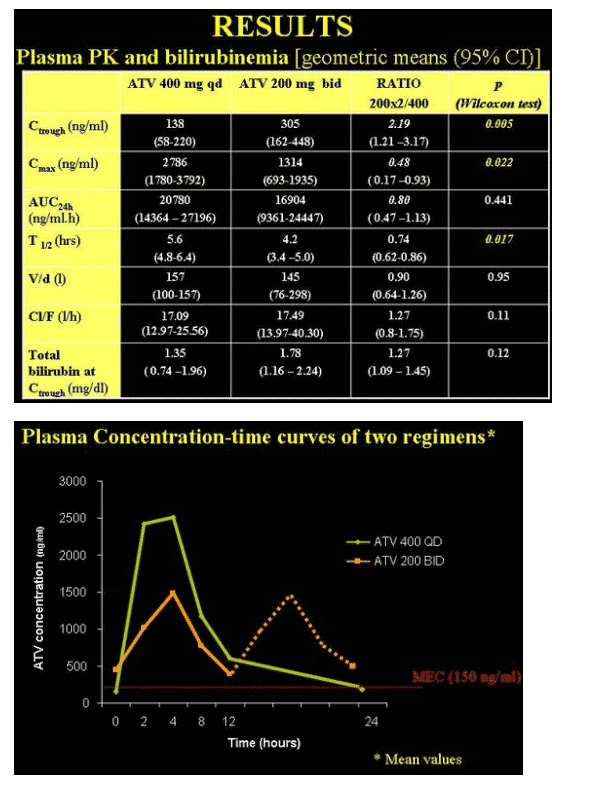
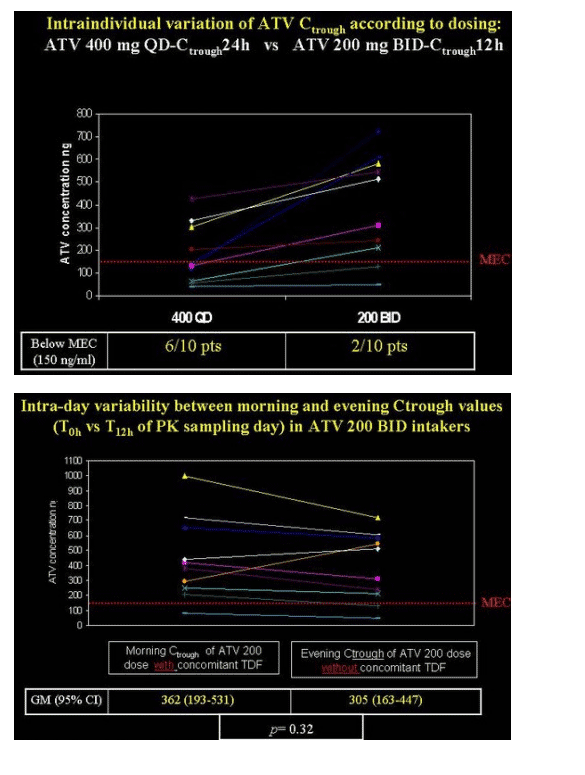
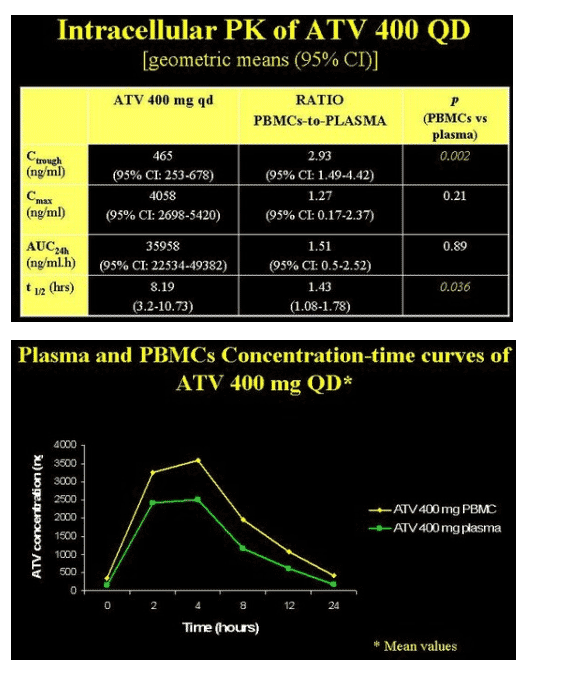
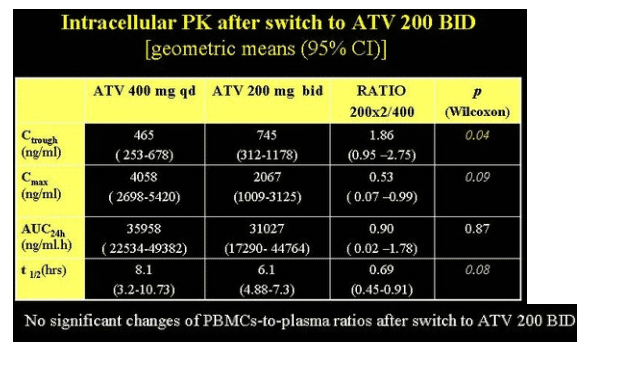
|
| |
|
 |
 |
|
|